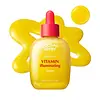What's inside
What's inside
 Key Ingredients
Key Ingredients

 Benefits
Benefits

 Concerns
Concerns

 Ingredients Side-by-side
Ingredients Side-by-side

Water
Skin ConditioningPropylene Glycol
HumectantPropanediol
SolventPEG-20m
Emulsion StabilisingHydroxyethylcellulose
Emulsion StabilisingNiacinamide
Smoothing3-O-Ethyl Ascorbic Acid
Skin ConditioningMethylparaben
PreservativeDisodium EDTA
Caprylhydroxamic Acid
Phenoxyethanol
PreservativeEthylhexylglycerin
Skin ConditioningPEG-40 Hydrogenated Castor Oil
EmulsifyingParfum
MaskingCI 19140
Cosmetic ColorantCI 45380
Cosmetic ColorantMalpighia Glabra Fruit Water
Skin ConditioningWater
Skin ConditioningButylene Glycol
HumectantGlycerin
HumectantCetyl Ethylhexanoate
EmollientNiacinamide
Smoothing1,2-Hexanediol
Skin ConditioningArbutin
AntioxidantHydrogenated Lecithin
EmulsifyingPentaerythrityl Tetrabehenate
EmollientDiethoxyethyl Succinate
SolventBetaine
HumectantCeramide NP
Skin ConditioningHydroxyethyl Urea
HumectantCaprylic/Capric Triglyceride
MaskingMelia Azadirachta Leaf Extract
Skin ConditioningCetearyl Alcohol
EmollientSqualane
EmollientMelia Azadirachta Flower Extract
Skin ConditioningPanthenol
Skin ConditioningCurcuma Longa Root Extract
MaskingTocopherol
AntioxidantCarbomer
Emulsion StabilisingButyrospermum Parkii Butter
Skin ConditioningTromethamine
BufferingXanthan Gum
EmulsifyingAllantoin
Skin ConditioningEthylhexylglycerin
Skin Conditioning2,3-Butanediol
HumectantAdenosine
Skin ConditioningOcimum Sanctum Leaf Extract
Skin ConditioningDisodium EDTA
Sodium Hyaluronate
HumectantSodium Carboxymethyl Beta-Glucan
CleansingCorallina Officinalis Extract
Skin ConditioningMalpighia Glabra Fruit Extract
Skin ConditioningGlyceryl Stearate
EmollientHydrolyzed Hyaluronic Acid
HumectantHydrolyzed Sodium Hyaluronate
Skin ConditioningHyaluronic Acid
HumectantHydroxypropyltrimonium Hyaluronate
Potassium Hyaluronate
Skin ConditioningRubus Fruticosus Fruit Extract
AstringentVaccinium Macrocarpon Fruit Extract
AstringentVaccinium Angustifolium Fruit Extract
Skin ProtectingRubus Idaeus Fruit Extract
AstringentSambucus Nigra Fruit Extract
AstringentCeramide Ns
Skin ConditioningCeramide As
Skin ConditioningCeramide AP
Skin ConditioningCholesterol
EmollientFerulic Acid
AntimicrobialGlutathione
Tranexamic Acid
Astringent3-O-Ethyl Ascorbic Acid
Skin ConditioningPentylene Glycol
Skin ConditioningSodium Hyaluronate Crosspolymer
HumectantSodium Acetylated Hyaluronate
HumectantCeramide EOP
Skin ConditioningMalpighia Glabra Fruit Water, Water, Butylene Glycol, Glycerin, Cetyl Ethylhexanoate, Niacinamide, 1,2-Hexanediol, Arbutin, Hydrogenated Lecithin, Pentaerythrityl Tetrabehenate, Diethoxyethyl Succinate, Betaine, Ceramide NP, Hydroxyethyl Urea, Caprylic/Capric Triglyceride, Melia Azadirachta Leaf Extract, Cetearyl Alcohol, Squalane, Melia Azadirachta Flower Extract, Panthenol, Curcuma Longa Root Extract, Tocopherol, Carbomer, Butyrospermum Parkii Butter, Tromethamine, Xanthan Gum, Allantoin, Ethylhexylglycerin, 2,3-Butanediol, Adenosine, Ocimum Sanctum Leaf Extract, Disodium EDTA, Sodium Hyaluronate, Sodium Carboxymethyl Beta-Glucan, Corallina Officinalis Extract, Malpighia Glabra Fruit Extract, Glyceryl Stearate, Hydrolyzed Hyaluronic Acid, Hydrolyzed Sodium Hyaluronate, Hyaluronic Acid, Hydroxypropyltrimonium Hyaluronate, Potassium Hyaluronate, Rubus Fruticosus Fruit Extract, Vaccinium Macrocarpon Fruit Extract, Vaccinium Angustifolium Fruit Extract, Rubus Idaeus Fruit Extract, Sambucus Nigra Fruit Extract, Ceramide Ns, Ceramide As, Ceramide AP, Cholesterol, Ferulic Acid, Glutathione, Tranexamic Acid, 3-O-Ethyl Ascorbic Acid, Pentylene Glycol, Sodium Hyaluronate Crosspolymer, Sodium Acetylated Hyaluronate, Ceramide EOP
 Reviews
Reviews

Ingredients Explained
These ingredients are found in both products.
Ingredients higher up in an ingredient list are typically present in a larger amount.
You might know this ingredient as Ethyl Ascorbic Acid, a more stable version of ascorbic acid.
Like other types of vitamin C, this ingredient has many benefits including reducing wrinkles, skin soothing, dark spot fading, and fighting against free radicals.
3-O-Ethyl Ascorbic Acid interferes with the process of skin darkening, helping to reduce hyperpigmentation. It also encourages the skin to produce more collagen.
Once applied, 3-O-Ethyl Ascorbic Acid is converted to Vitamin C deeper in the skin's layers. This process is slow but makes this ingredient more tolerable for skin.
The optimum pH range for this ingredient is 4 - 5.5
Learn more about 3-O-Ethyl Ascorbic AcidDisodium EDTA plays a role in making products more stable by aiding other preservatives.
It is a chelating agent, meaning it neutralizes metal ions that may be found in a product.
Disodium EDTA is a salt of edetic acid and is found to be safe in cosmetic ingredients.
Learn more about Disodium EDTAEthylhexylglycerin (we can't pronounce this either) is commonly used as a preservative and skin softener. It is derived from glyceryl.
You might see Ethylhexylglycerin often paired with other preservatives such as phenoxyethanol. Ethylhexylglycerin has been found to increase the effectiveness of these other preservatives.
Niacinamide is a multitasking form of vitamin B3 that strengthens the skin barrier, reduces pores and dark spots, regulates oil, and improves signs of aging.
And the best part? It's gentle and well-tolerated by most skin types, including sensitive and reactive skin.
You might have heard of "niacin flush", or the reddening of skin that causes itchiness. Niacinamide has not been found to cause this.
In very rare cases, some individuals may not be able to tolerate niacinamide at all or experience an allergic reaction to it.
If you are experiencing flaking, irritation, and dryness with this ingredient, be sure to double check all your products as this ingredient can be found in all categories of skincare.
When incorporating niacinamide into your routine, look out for concentration amounts. Typically, 5% niacinamide provides benefits such as fading dark spots. However, if you have sensitive skin, it is better to begin with a smaller concentration.
When you apply niacinamide to your skin, your body converts it into nicotinamide adenine dinucleotide (NAD). NAD is an essential coenzyme that is already found in your cells as "fuel" and powers countless biological processes.
In your skin, NAD helps repair cell damage, produce new healthy cells, support collagen production, strengthen the skin barrier, and fight environmental stressors (like UV and pollution).
Our natural NAD levels start to decline with age, leading to slower skin repair, visible aging, and a weaker skin barrier. By providing your skin niacinamide, you're recharging your skin's NAD levels. This leads to stronger, healthier, and younger looking skin.
Another name for vitamin B3 is nicotinamide. This vitamin is water-soluble and our bodies don't store it. We obtain Vitamin B3 from either food or skincare. Meat, fish, wheat, yeast, and leafy greens contain vitamin B3.
The type of niacinamide used in skincare is synthetically created.
Learn more about NiacinamideWater. It's the most common cosmetic ingredient of all. You'll usually see it at the top of ingredient lists, meaning that it makes up the largest part of the product.
So why is it so popular? Water most often acts as a solvent - this means that it helps dissolve other ingredients into the formulation.
You'll also recognize water as that liquid we all need to stay alive. If you see this, drink a glass of water. Stay hydrated!
Learn more about Water